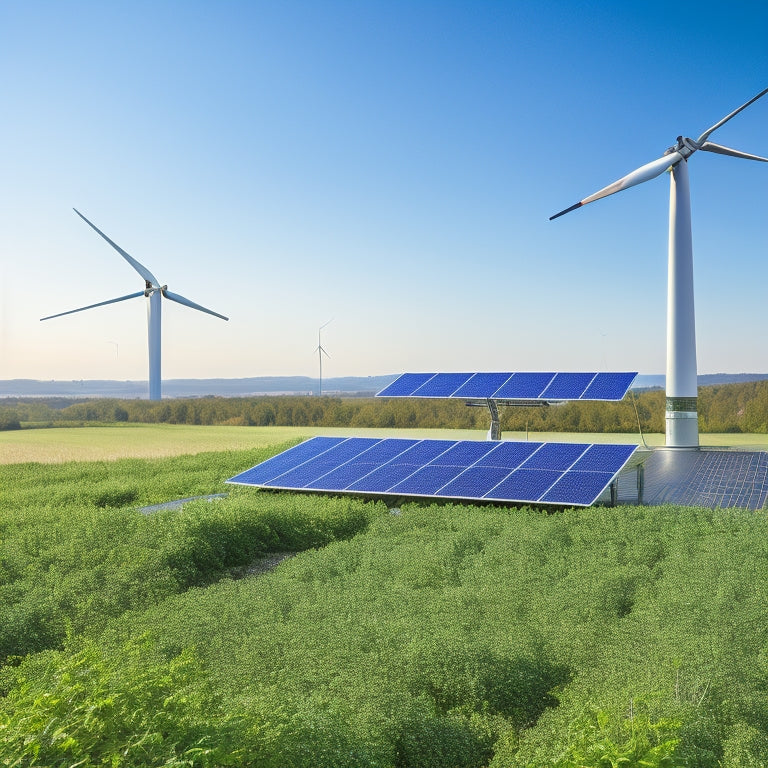
Why Regular Maintenance Matters for Rooftop Harvesting Systems
Share
You depend on your rooftop harvesting system to provide a dependable source of water, but overlooking routine maintenance can have serious repercussions. Contaminated water, system failures, and even roof damage can occur if you don't prioritize upkeep. Regular inspections and maintenance decrease the chances of waterborne health risks, system downtime, and costly repairs. By staying on top of maintenance, you'll guarantee top-notch water quality, prolong your system's lifespan, and safeguard your roof's integrity. To avoid these pitfalls and maintain the smooth operation of your system, grasping the significance of regular maintenance - and what it involves - is vital.
Key Takeaways
• Regular maintenance prevents water contamination risks, ensuring safe water quality and reducing health risks from harmful microorganisms.
• Proper upkeep reduces system failure likelihood, avoiding downtime and repair costs, and mitigating the risk of sudden failures.
• Regular maintenance guarantees optimal water quality by prioritizing water testing, monitoring parameters, and taking corrective actions when needed.
• Maintaining rooftop harvesting systems extends their lifespan, reduces the need for premature replacements, and contributes to significant cost savings and sustainability benefits.
• Regular inspections and maintenance protect roof integrity, preventing leaks, wear, damage, or corrosion, and ensuring the roof remains intact and secure.
Preventing Water Contamination Risks
You must make sure that your rooftop harvesting system is regularly inspected and maintained to prevent contamination risks, as even slight neglect can lead to compromised water quality.
Contamination prevention is vital, as it directly affects the health risks associated with consuming harvested rainwater. Failing to maintain your system can lead to the growth of harmful microorganisms, which can cause waterborne diseases.
Additionally, contaminated water can also have a negative environmental impact, affecting local ecosystems and wildlife.
Regular maintenance helps identify potential sources of contamination, such as debris accumulation, clogged gutters, and damaged roofing materials.
By addressing these issues promptly, you can guarantee that your harvested water meets the required quality standards.
It's crucial to inspect your system regularly, checking for signs of wear and tear, and performing routine cleaning and disinfection tasks.
Reducing System Failure Chances
Regular maintenance also plays a critical role in reducing the likelihood of system failure, which can render your rooftop harvesting system inoperable and result in costly repairs or even complete replacement. By performing routine checks and tasks, you'll be able to identify potential issues before they escalate into major problems. This preventive maintenance approach enables you to address minor faults and wear-and-tear, thereby mitigating the risk of system failure.
You'll avoid unnecessary downtime, reduce repair costs, and guarantee your system operates efficiently. Additionally, regular maintenance helps you stay on top of component replacements, ensuring that your system remains in good working condition. By doing so, you'll minimize the likelihood of sudden failures, which can lead to water loss, property damage, or even safety hazards.
Maintaining Optimal Water Quality
Proper upkeep of your rooftop harvesting system is essential to guaranteeing the water it gathers is safe for irrigation, toilet flushing, or other intended uses, as contaminants and debris can quickly compromise water quality. You must prioritize regular water testing to detect any changes in water chemistry that could affect its suitability for use. This involves monitoring parameters such as pH, turbidity, and bacterial counts.
If you notice any deviations from acceptable limits, you'll need to take corrective action, which may involve filter replacement or adjustments to your treatment process. Filter replacement is a critical aspect of maintaining peak water quality, as clogged or degraded filters can allow contaminants to pass through. By replacing filters according to the manufacturer's schedule, you can ensure that your system continues to produce high-quality water.
Extending System Lifespan Benefits
By prioritizing regular maintenance, rooftop harvesting systems can enjoy an extended lifespan, reducing the need for premature replacements and minimizing downtime. This, in turn, leads to significant cost savings for you and your organization. When systems are properly maintained, components last longer, and the likelihood of costly repairs or replacements decreases. Additionally, regular maintenance helps to identify and address potential issues before they become major problems, further reducing the risk of unexpected expenses.
Regular maintenance also contributes to sustainability benefits. By extending the lifespan of your rooftop harvesting system, you're reducing the environmental impact of frequent replacements and waste generation. Furthermore, a well-maintained system operates more efficiently, using fewer resources and minimizing its carbon footprint. By taking proactive steps to maintain your rooftop harvesting system, you're not only saving money but also doing your part for the environment.
Ensuring Roof Integrity Protection
You must make certain that your rooftop harvesting system is designed and installed to protect the integrity of your roof, as even minor damage can lead to costly repairs, water ingress, or even roof collapse.
A well-designed system will guarantee that your roof remains intact, while also providing a reliable source of harvested water.
Regular roof inspections are essential to identifying potential issues before they become significant problems. During these inspections, look for signs of wear, damage, or corrosion on the roof's surface, as well as around the system's components.
Additionally, perform routine checks on the system's connections, seals, and joints to prevent leaks. Leak prevention is key to maintaining the integrity of your roof and preventing water damage.
By catching and addressing issues early, you can avoid costly repairs and ensure the longevity of your rooftop harvesting system.
Frequently Asked Questions
How Often Should I Inspect My Rooftop Harvesting System for Damage?
You should inspect your rooftop harvesting system every 3-6 months to prevent damage, checking for signs of wear, corrosion, and blockages, and performing routine cleaning and repairs to guarantee peak performance and longevity.
Can I Perform Maintenance Tasks Without Professional Assistance?
Can you really afford to gamble with your rooftop harvesting system's performance? You can attempt DIY maintenance, but for complex tasks, don't risk compromising safety and efficiency - seek professional assistance to achieve the best results.
Are There Any Specific Tools Required for Maintenance Tasks?
When performing maintenance tasks, you'll need a maintenance checklist and essential equipment like a multimeter, wrench, and safety gear to guarantee you're prepared to tackle tasks efficiently and safely.
How Do I Determine the Optimal Maintenance Schedule for My System?
You'll determine the best maintenance schedule for your rooftop harvesting system by analyzing its specific needs, considering factors like rainfall, water quality, and system usage, to establish the right frequency for tasks like cleaning and inspections.
What Are the Consequences of Neglecting Regular Maintenance Tasks?
As you let maintenance slip, your system's heartbeat falters, and water quality suffers. You'll face dwindling system efficiency, risking contamination and structural damage, which can have devastating consequences for those relying on your harvest.
Related Posts
-

What Makes a Beautiful Border Planter Design
When crafting a beautiful border planter design, you balance fundamental elements like durable cinder block structure...
-

What Makes a Beautiful Border Planter Design
When crafting a beautiful border planter design, you balance fundamental elements like durable cinder block structure...
-

What Makes a Beautiful Border Planter Design
When crafting a beautiful border planter design, you balance fundamental elements like durable cinder block structure...
-

What Makes a Beautiful Border Planter Design
When crafting a beautiful border planter design, you balance fundamental elements like durable cinder block structure...
-

What Makes a Beautiful Border Planter Design
When crafting a beautiful border planter design, you balance fundamental elements like durable cinder block structure...
-

What Makes a Beautiful Border Planter Design
When crafting a beautiful border planter design, you balance fundamental elements like durable cinder block structure...
-

What Makes a Beautiful Border Planter Design
When crafting a beautiful border planter design, you balance fundamental elements like durable cinder block structure...
-

What Makes a Beautiful Border Planter Design
When crafting a beautiful border planter design, you balance fundamental elements like durable cinder block structure...
-

What Makes a Beautiful Border Planter Design
When crafting a beautiful border planter design, you balance fundamental elements like durable cinder block structure...
-

What Makes a Beautiful Border Planter Design
When crafting a beautiful border planter design, you balance fundamental elements like durable cinder block structure...
-

What Makes a Beautiful Border Planter Design
When crafting a beautiful border planter design, you balance fundamental elements like durable cinder block structure...
-

What Makes a Beautiful Border Planter Design
When crafting a beautiful border planter design, you balance fundamental elements like durable cinder block structure...
-

What Makes a Beautiful Border Planter Design
When crafting a beautiful border planter design, you balance fundamental elements like durable cinder block structure...
-

What Makes a Beautiful Border Planter Design
When crafting a beautiful border planter design, you balance fundamental elements like durable cinder block structure...
-

What Makes a Beautiful Border Planter Design
When crafting a beautiful border planter design, you balance fundamental elements like durable cinder block structure...
-

What Makes a Beautiful Border Planter Design
When crafting a beautiful border planter design, you balance fundamental elements like durable cinder block structure...
-

What Makes a Beautiful Border Planter Design
When crafting a beautiful border planter design, you balance fundamental elements like durable cinder block structure...
-

What Makes a Beautiful Border Planter Design
When crafting a beautiful border planter design, you balance fundamental elements like durable cinder block structure...
-

What Makes a Beautiful Border Planter Design
When crafting a beautiful border planter design, you balance fundamental elements like durable cinder block structure...
-

What Makes a Beautiful Border Planter Design
When crafting a beautiful border planter design, you balance fundamental elements like durable cinder block structure...
-

What Makes a Beautiful Border Planter Design
When crafting a beautiful border planter design, you balance fundamental elements like durable cinder block structure...
-

What Makes a Beautiful Border Planter Design
When crafting a beautiful border planter design, you balance fundamental elements like durable cinder block structure...
-

What Makes a Beautiful Border Planter Design
When crafting a beautiful border planter design, you balance fundamental elements like durable cinder block structure...
-

What Makes a Beautiful Border Planter Design
When crafting a beautiful border planter design, you balance fundamental elements like durable cinder block structure...
-

What Makes a Beautiful Border Planter Design
When crafting a beautiful border planter design, you balance fundamental elements like durable cinder block structure...
-

What Makes a Beautiful Border Planter Design
When crafting a beautiful border planter design, you balance fundamental elements like durable cinder block structure...
-

What Makes a Beautiful Border Planter Design
When crafting a beautiful border planter design, you balance fundamental elements like durable cinder block structure...
-

What Makes a Beautiful Border Planter Design
When crafting a beautiful border planter design, you balance fundamental elements like durable cinder block structure...
-

What Makes a Beautiful Border Planter Design
When crafting a beautiful border planter design, you balance fundamental elements like durable cinder block structure...
-

What Makes a Beautiful Border Planter Design
When crafting a beautiful border planter design, you balance fundamental elements like durable cinder block structure...
-

What Makes a Beautiful Border Planter Design
When crafting a beautiful border planter design, you balance fundamental elements like durable cinder block structure...
-

5 Best Trowels for Planting in Concrete Planters
When planting in concrete planters, you need a trowel that can handle the harsh conditions and reduce fatigue on your...
-

5 Best Trowels for Planting in Concrete Planters
When planting in concrete planters, you need a trowel that can handle the harsh conditions and reduce fatigue on your...
-

5 Best Trowels for Planting in Concrete Planters
When planting in concrete planters, you need a trowel that can handle the harsh conditions and reduce fatigue on your...
-

5 Best Trowels for Planting in Concrete Planters
When planting in concrete planters, you need a trowel that can handle the harsh conditions and reduce fatigue on your...
-

5 Best Trowels for Planting in Concrete Planters
When planting in concrete planters, you need a trowel that can handle the harsh conditions and reduce fatigue on your...
-

5 Best Trowels for Planting in Concrete Planters
When planting in concrete planters, you need a trowel that can handle the harsh conditions and reduce fatigue on your...
-

5 Best Trowels for Planting in Concrete Planters
When planting in concrete planters, you need a trowel that can handle the harsh conditions and reduce fatigue on your...
-

5 Best Trowels for Planting in Concrete Planters
When planting in concrete planters, you need a trowel that can handle the harsh conditions and reduce fatigue on your...
-

5 Best Trowels for Planting in Concrete Planters
When planting in concrete planters, you need a trowel that can handle the harsh conditions and reduce fatigue on your...
-

5 Best Trowels for Planting in Concrete Planters
When planting in concrete planters, you need a trowel that can handle the harsh conditions and reduce fatigue on your...
-

5 Best Trowels for Planting in Concrete Planters
When planting in concrete planters, you need a trowel that can handle the harsh conditions and reduce fatigue on your...
-

5 Best Trowels for Planting in Concrete Planters
When planting in concrete planters, you need a trowel that can handle the harsh conditions and reduce fatigue on your...
-

5 Best Trowels for Planting in Concrete Planters
When planting in concrete planters, you need a trowel that can handle the harsh conditions and reduce fatigue on your...
-

5 Best Trowels for Planting in Concrete Planters
When planting in concrete planters, you need a trowel that can handle the harsh conditions and reduce fatigue on your...
-

5 Best Trowels for Planting in Concrete Planters
When planting in concrete planters, you need a trowel that can handle the harsh conditions and reduce fatigue on your...
-

5 Best Trowels for Planting in Concrete Planters
When planting in concrete planters, you need a trowel that can handle the harsh conditions and reduce fatigue on your...
-

5 Best Trowels for Planting in Concrete Planters
When planting in concrete planters, you need a trowel that can handle the harsh conditions and reduce fatigue on your...
-

5 Best Trowels for Planting in Concrete Planters
When planting in concrete planters, you need a trowel that can handle the harsh conditions and reduce fatigue on your...
-

Summer Care Tips for Concrete Planters
As you step into the warmest season of the year, your concrete planters require deliberate care to thrive. Clean your...
-

Summer Care Tips for Concrete Planters
As you step into the warmest season of the year, your concrete planters require deliberate care to thrive. Clean your...
-

Summer Care Tips for Concrete Planters
As you step into the warmest season of the year, your concrete planters require deliberate care to thrive. Clean your...
-

Summer Care Tips for Concrete Planters
As you step into the warmest season of the year, your concrete planters require deliberate care to thrive. Clean your...
-

Summer Care Tips for Concrete Planters
As you step into the warmest season of the year, your concrete planters require deliberate care to thrive. Clean your...
-

Summer Care Tips for Concrete Planters
As you step into the warmest season of the year, your concrete planters require deliberate care to thrive. Clean your...
-

Summer Care Tips for Concrete Planters
As you step into the warmest season of the year, your concrete planters require deliberate care to thrive. Clean your...
-

Summer Care Tips for Concrete Planters
As you step into the warmest season of the year, your concrete planters require deliberate care to thrive. Clean your...
-

Summer Care Tips for Concrete Planters
As you step into the warmest season of the year, your concrete planters require deliberate care to thrive. Clean your...
-

Summer Care Tips for Concrete Planters
As you step into the warmest season of the year, your concrete planters require deliberate care to thrive. Clean your...
-

Summer Care Tips for Concrete Planters
As you step into the warmest season of the year, your concrete planters require deliberate care to thrive. Clean your...
-

Summer Care Tips for Concrete Planters
As you step into the warmest season of the year, your concrete planters require deliberate care to thrive. Clean your...
-

Summer Care Tips for Concrete Planters
As you step into the warmest season of the year, your concrete planters require deliberate care to thrive. Clean your...
-

Summer Care Tips for Concrete Planters
As you step into the warmest season of the year, your concrete planters require deliberate care to thrive. Clean your...
-

Summer Care Tips for Concrete Planters
As you step into the warmest season of the year, your concrete planters require deliberate care to thrive. Clean your...
-

Summer Care Tips for Concrete Planters
As you step into the warmest season of the year, your concrete planters require deliberate care to thrive. Clean your...
-

Summer Care Tips for Concrete Planters
As you step into the warmest season of the year, your concrete planters require deliberate care to thrive. Clean your...
-

Summer Care Tips for Concrete Planters
As you step into the warmest season of the year, your concrete planters require deliberate care to thrive. Clean your...
-

Summer Care Tips for Concrete Planters
As you step into the warmest season of the year, your concrete planters require deliberate care to thrive. Clean your...
-

Summer Care Tips for Concrete Planters
As you step into the warmest season of the year, your concrete planters require deliberate care to thrive. Clean your...
-

Summer Care Tips for Concrete Planters
As you step into the warmest season of the year, your concrete planters require deliberate care to thrive. Clean your...
-

Summer Care Tips for Concrete Planters
As you step into the warmest season of the year, your concrete planters require deliberate care to thrive. Clean your...
-

Summer Care Tips for Concrete Planters
As you step into the warmest season of the year, your concrete planters require deliberate care to thrive. Clean your...
-

Summer Care Tips for Concrete Planters
As you step into the warmest season of the year, your concrete planters require deliberate care to thrive. Clean your...
-

Summer Care Tips for Concrete Planters
As you step into the warmest season of the year, your concrete planters require deliberate care to thrive. Clean your...
-

Summer Care Tips for Concrete Planters
As you step into the warmest season of the year, your concrete planters require deliberate care to thrive. Clean your...
-

Summer Care Tips for Concrete Planters
As you step into the warmest season of the year, your concrete planters require deliberate care to thrive. Clean your...
-

Summer Care Tips for Concrete Planters
As you step into the warmest season of the year, your concrete planters require deliberate care to thrive. Clean your...
-

Summer Care Tips for Concrete Planters
As you step into the warmest season of the year, your concrete planters require deliberate care to thrive. Clean your...


